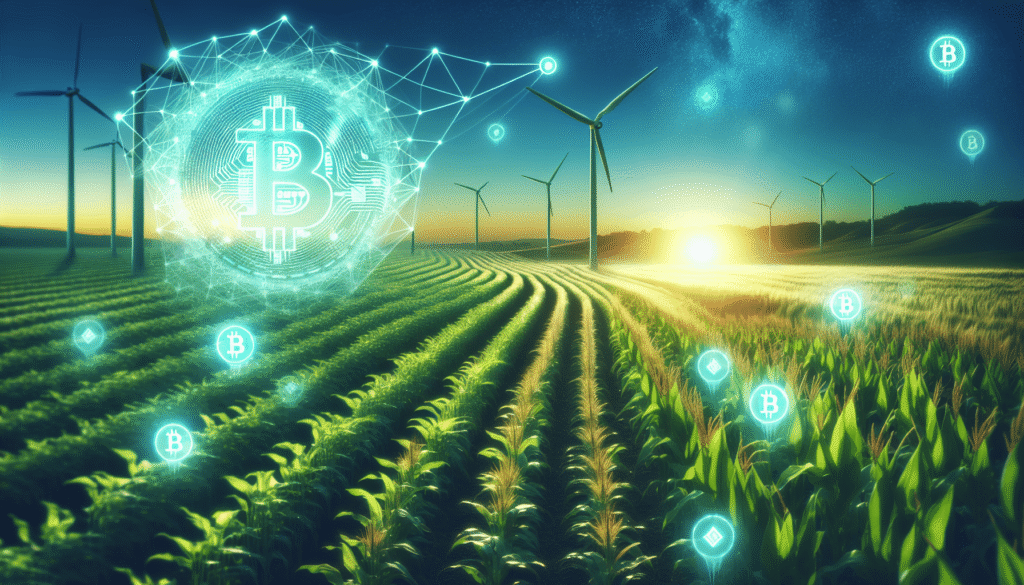Have you ever considered how the world of digital currencies might revolutionize our approach to sustainable agriculture? In an age where technological advancements are influencing nearly every facet of our lives, from communication to transportation, it seems only natural that agriculture—a sector as old as human civilization itself—should evolve as well. The intersection of cryptocurrency and sustainable agriculture might not immediately come to mind, but it’s a meeting point that holds a lot of potential.
The Foundation: Understanding Cryptocurrency
Cryptocurrency might seem like a complicated term, but it’s simpler once you break it down. Cryptocurrency is a form of digital or virtual currency that uses cryptography for security. Unlike traditional currencies issued by governments, cryptocurrencies operate on technology called blockchain, a distributed ledger enforced by a network of computers, also known as nodes.
The Basics of Blockchain Technology
Traditional currencies rely on central banks to ensure their value and process transactions. Blockchain technology, however, decentralizes this process. Each transaction is recorded on a block and added to a public chain, creating a permanent and transparent transaction history. This system not only ensures the security and transparency of information but also prevents manipulation or revision of data by any single entity.
Decentralization: A Key Advantage
One of the main advantages of cryptocurrency and blockchain is decentralization. Without the need for intermediaries like banks, transactions can be processed more efficiently, with lower fees, and with greater security. This feature has already found applications in sectors like finance, supply chain, and healthcare. But what about agriculture?
Sustainable Agriculture: An Overview
Before delving into the potential synergies between crypto and sustainable agriculture, it’s pivotal to grasp what sustainable agriculture encompasses. At its core, sustainable agriculture aims to meet the needs of the present without compromising future generations’ ability to do the same. This involves a holistic approach that considers environmental health, economic profitability, and social and economic equity.
Environmental Health
Sustainable practices involve minimizing synthetic inputs, preserving soil health, decreasing water use, and enhancing biodiversity. These efforts culminate in both restoring ecosystems and reducing agriculture’s carbon footprint.
Economic Viability
Farmers need to maintain economic viability to stay in business and provide food. Sustainable agriculture emphasizes efficient practices that don’t deplete resources or harm the environment but still deliver economically.
Social Equity
Sustainability also means ensuring fair labor conditions, supporting local communities, and retaining traditional agricultural knowledge. It’s about creating systems that work for everyone involved in the food chain, from producers to consumers.

The Intersection: How Crypto Can Benefit Sustainable Agriculture
Cryptocurrencies bring several transformative potentials to sustainable agriculture. Their introduction can offer innovative solutions such as transparent payment systems, funding opportunities, and the integration of data-driven farming techniques.
Crypto for Transparent Payment Systems
Using blockchain for transactions ensures transparency and traceability. Farmers and consumers can track produce from farm to table, ensuring fair trade and ethical practices. This technology could potentially eliminate mistrust in the food supply chain by providing verified information about the source, sustainability practices, and journey of a product.
Micro-Investments and Crowdfunding
Cryptocurrency can facilitate micro-investments, allowing more people to contribute to sustainable farming projects. Blockchain platforms can support crowdfunding campaigns, helping farmers access the necessary capital without relying on traditional means. This democratization of investment creates opportunities for small-scale farms to implement sustainable practices.
Data Collection and Smart Farming
Blockchain can facilitate more efficient data collection, essential for optimizing farming practices. Cryptocurrencies can be coupled with Internet of Things (IoT) devices to collect real-time data on soil moisture, crop health, etc., which can then be shared and analyzed transparently across the chain. This integration can significantly reduce waste and enhance productivity.
Table: Benefits of Crypto Integration in Agriculture
| Benefit | Impact |
|---|---|
| Transparent Transactions | Increases trust and transparency in the food supply chain. |
| Micro-Investments | Provides financial support for sustainable projects. |
| Real-time Data Collection | Enhances smart farming with accurate data. |
Challenges and Considerations
As with any integration of new technology, challenges and considerations come into play. While the potential is vast, it is essential to address these hurdles for successful implementation.
Technological Accessibility and Literacy
For many farmers, especially in developing regions, access to technology and the internet remains limited. Adequate training and resources are crucial for these communities to capitalize on blockchain’s potential.
Volatility of Cryptocurrencies
The value of cryptocurrencies can be highly volatile, posing a risk for projects that rely on stable funding. Farmers need reassurances or mechanisms to stabilize this variability for sustainable planning.
Regulatory Landscape
As governments worldwide grapple with regulating cryptocurrencies, it remains uncertain how regulations might affect their application in agriculture. A cooperative approach between regulators and industry players is necessary to develop frameworks that encourage innovation while protecting stakeholders.

Moving Forward: Bridging the Gap
So, how can we move from potential to practice? Collaboration is key. Stakeholders across the technology and agriculture sectors, from startups to governments, should work together to explore pilot projects and develop holistic solutions.
Partnerships and Education
Creating partnerships between tech companies and agricultural organizations can facilitate the development of user-friendly tools tailored specifically for farmers. Education plays a crucial role in this process, as equipping farmers with the knowledge and confidence to use these technologies will be vital.
Pilot Programs and Case Studies
Encouraging pilot programs within different agricultural contexts can provide valuable insights and build a repository of best practices. Sharing case studies from successful implementations can inspire wider adoption and adaptation.
Inclusivity and Innovation
Ensuring inclusivity in the development and implementation of these technologies will help create more equitable and effective solutions. Different voices and experiences can drive innovation that meets diverse needs and addresses global challenges.
Conclusion
The fusion of cryptocurrency and sustainable agriculture offers tremendous potential for reshaping the future of farming. By leveraging transparency, democratizing investment, and utilizing real-time data, we can build more resilient, efficient, and sustainable agricultural systems. While challenges such as technological access, volatility, and regulatory uncertainties exist, collaborative efforts and continuous learning will pave the way forward. It’s an exciting time in agriculture, and embracing these technological advancements might just be the key to feeding the future sustainably.

